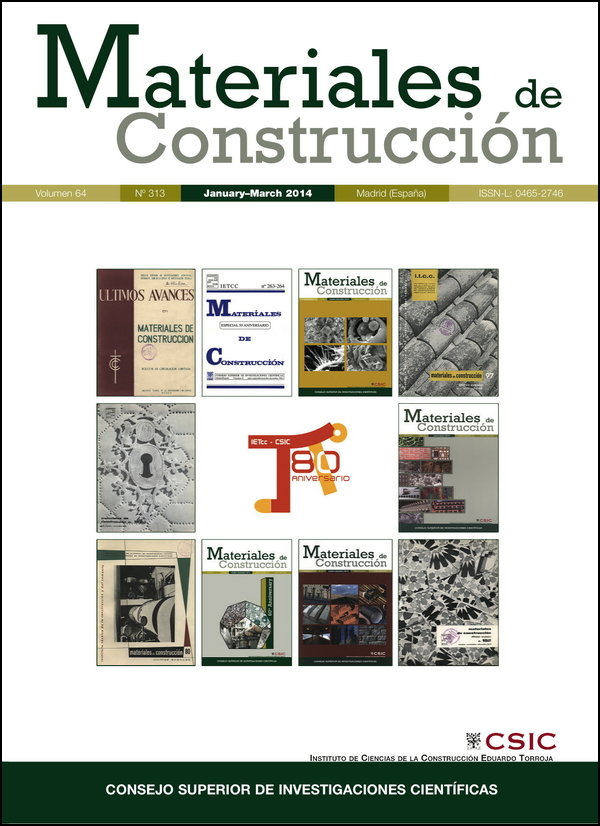Pathology of Building Materials in Historic Buildings. Relationship Between Laboratory Testing and Infrared Thermography
DOI:
https://doi.org/10.3989/mc.2013.06612Keywords:
Limestone, decay, physical properties, thermal analysisAbstract
Study of historic buildings requires a pathology analysis of the construction materials used in order to define their conservation state. Usually we can find capillary moisture, salt crystalli-zation or density differences by deterioration. Sometimes this issue is carried out by destructive testing which determine materials’ physical and chemical characteristics. However, they are unfavorable regarding the building’s integrity, and they are sometimes difficult to implement. This paper presents a technique using infrared thermography to analyze the existing pathology and has the advantage of being able to diagnose inaccessible areas in buildings. The results obtained by this technique have been compared with those obtained in the laboratory, in order to validate this study and thus to extrapolate the methodology to other buildings and materials.
Downloads
References
1. Fitzner, B. en VV. AA (1996). Técnicas de diagnóstico aplicadas a la conservación de los materiales de construcción en los edificios históricos. Sevilla: Junta de Andalucía.
2. Válek, J.; Kruschwitz, S.; Wostmann, J.; Kind, T.; Valach, J.; Kopp, C.; Lesák, J. (2010) Nondestructive investigation of wet building material: multimethodical approach. Journal of performance of constructed facilities, 462–472. http://dx.doi.org/10.1061/(ASCE)CF.1943-5509.0000056
3. Danese, M.; Demsar, U.; Masini, N.; Charlton, M. (2010) Investigating material decay of historic buildings using visual analytics with multi-temporal infrared thermographic data. Archaeometry, 52 [3], 482–501. http://dx.doi.org/10.1111/j.1475-4754.2009.00485.x
4. Campbell, J.B. (1996) Introduction to remote sensing, 2° ed., Taylor & Francis, London.
5. Lerma, JL.; Cabrelles, M.; Portalés, C. (2011) Multitemporal thermal analysis to detect moisture on a building façade. Constr. Build. Mater. 25, 2190–2197. http://dx.doi.org/10.1016/j.conbuildmat.2010.10.007
6. Meola, C.; Carlomagno, G.M.; Giorleo, L. (2004) The use of infrared thermography for materials characterization. J. Mater. Process. Technol., 155–156, 1132–1137. http://dx.doi.org/10.1016/j.jmatprotec.2004.04.268
7. Rodríguez Li-án, C. (2011) Inspección mediante técnicas no destructivas de un edificio histórico: oratorio San Felipe Neri (Cádiz). Informes de la Construcción 63, 13–22. http://dx.doi.org/10.3989/ic.10.032
8. Ca-as I. (2005) Thermal-physical aspects of materials used for the construction or rural buildings in Soria (Spain). Constr. Build. Mater. 19, 197–211. http://dx.doi.org/10.1016/j.conbuildmat.2004.05.016
9. Mercuri, F.; Zammit, U.; Orazi, N.; Paoloni, S.; Marinelli, M.; Scudieri, F. (2011) Active infrared thermography applied to the investigation of art and historic artefacts. J. Therm. Anal. Calorim. 104, 475–485. http://dx.doi.org/10.1007/s10973-011-1450-8
10. Ordaz, J.; Esbert, R.M. (1988) Glosario de términos relacionados con el deterioro de las piedras de construcción. Mater. Construcc. 38 [209], ene-feb-mar, 1988.
11. González Cruz, E.M. (2003) Selección de materiales en la concepción arquitectónica bioclimática. Instituto de investigaciones de la Facultad de Arquitectura y Dise-o, Universidad de Zulia. Venezuela. PMid:12970009
12. Rodríguez-Li-án, C.; Morales-Conde, M.J.; Rubio-de Hita, P.; Pérez-Galve, F. (2012) Analysis of the influence of density on infrared thermography and of the scope of this technique in the detection of internal defects in wood. Mater. Construcc. 62 [305], 99–113.
13. Hammecker, C. (1995) The importance of the petrophysical properties and external factors in stone decay on monuments. Pageoph. 145, 337–361. http://dx.doi.org/10.1007/BF00880275
14. Scherer, G.W. (1990) The theory of drying. J Am Ceram Soc. 73, 3–14. http://dx.doi.org/10.1111/j.1151-2916.1990.tb05082.x
15. Freitas, D.S. (2000) Pore network simulation of evaporation of a binary liquid from a capillary porous médium. Transp. Porous Media. 40, 1–25. http://dx.doi.org/10.1023/A:1006651524722
16. Rirsch, E.; Zhang, Z. (2010) Rising damp in masonry walls and the importance of mortar properties. Constr. Build. Mater. 24, 1815–1820. http://dx.doi.org/10.1016/j.conbuildmat.2010.04.024
17. Hall, C.; Hoff, W.D. (2002) Water transport in brick, stone and concrete. London: Spon Press. http://dx.doi.org/10.4324/9780203301708
18. Oliver, A. (1988) Dampness in buildings. Oxford: BSP Professional Books.
19. Buj, O.; López, P.L.; Gisbert, J. (2010) Characterization of pore system and their influence on decay rates caused by salt weathering on limestones and dolostones quarried in Abanto (Zaragoza, Spain). Mater. Construcc, 60 [299], 99–114. http://dx.doi.org/10.3989/mc.2010.50108
20. Rossi-Manaresi, R. (1988) Degradación del Patrimonio. Conferencia celebrada en la Facultad de Geografía e Historia. Valencia.
21. Gayo, E.; De Frutos, J.; Palomo, A.; Massa, S.A. (1996) Mathematical Model Simulating the Evaporation Processes in Building Materials: Experimental Checking through Infrared Thermography. Building and Environment, 31 [5], 469–475. http://dx.doi.org/10.1016/0360-1323(96)00007-8
22. D'Oracio, M.; Munafò, P. (2013) A methodology for the evaluation of the hygrometric and mechanical properties of consolidated stones. International Journal of Architectural Heritage.
23. Binda, L.; Gardani, G.; Zanzi, L. (2010) Nondestructive testing evaluation of drying process in flooded full-scale masonry walls. J. Perform. Constr. Facil. 24, Sp. Issue: Flood Impact to Heritage Structures, 473–483.
24. De Clercq, H. (2008) Proc. Conference on salt weathering on buildings and stone sculptures. Copenhagen: Tech University of Denmark.
Published
How to Cite
Issue
Section
License
Copyright (c) 2014 Consejo Superior de Investigaciones Científicas (CSIC)

This work is licensed under a Creative Commons Attribution 4.0 International License.
© CSIC. Manuscripts published in both the print and online versions of this journal are the property of the Consejo Superior de Investigaciones Científicas, and quoting this source is a requirement for any partial or full reproduction.
All contents of this electronic edition, except where otherwise noted, are distributed under a Creative Commons Attribution 4.0 International (CC BY 4.0) licence. You may read the basic information and the legal text of the licence. The indication of the CC BY 4.0 licence must be expressly stated in this way when necessary.
Self-archiving in repositories, personal webpages or similar, of any version other than the final version of the work produced by the publisher, is not allowed.
















